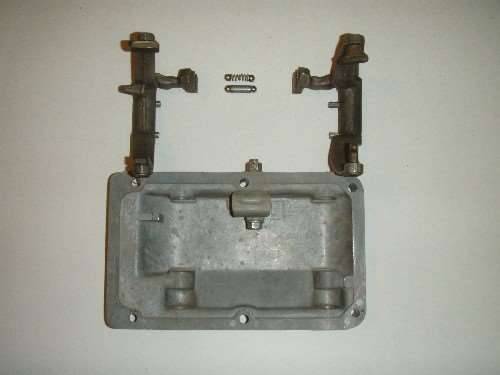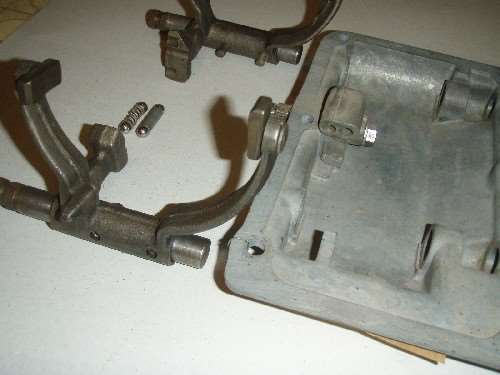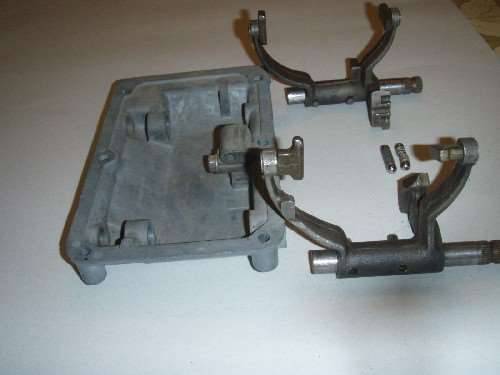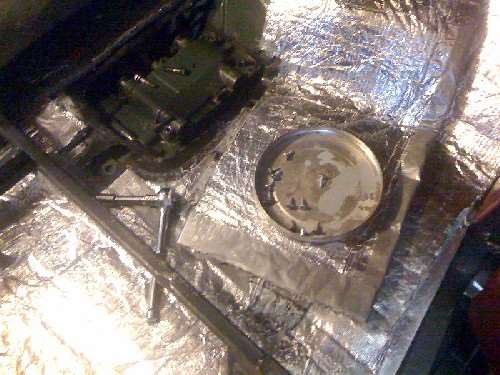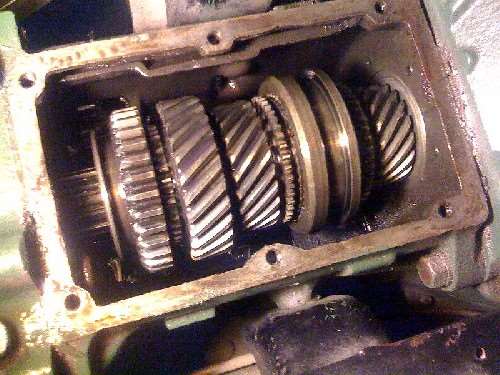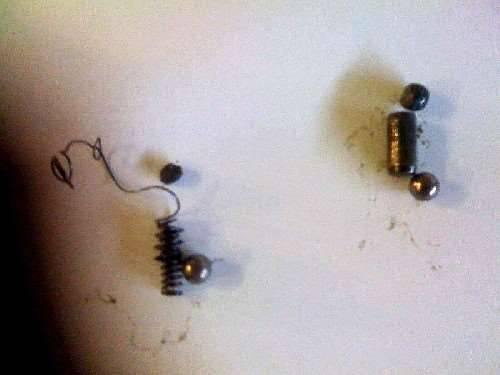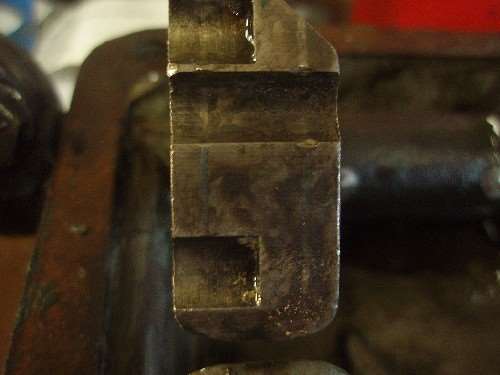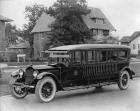|
Re: 1940 Manual shift
|
||||
|---|---|---|---|---|
|
Forum Ambassador

|
Joe -
I never worked on one of these, but during my work on the site's Service Index, I found several topics on the column shift issues. The most comprehensive article I found was titled, That Gearshift Still Sticks, in SC Vol. 20, No. 5, which reiterates checks and corrections for lost motion in the linkage; new forged column levers were also announced. There article also refers the reader to a couple of earlier articles. Locking in Gear, in SL Vol. 15, No. 5, focuses on a problem of sticking in low, shifting to neutral, advising of a production change that did away with a spring washer to control clearance in the shift lever assembly, in favor of new, selective shims. Sticking in Low Gear, in SL Vol. 16, No. 10, details issues involving loose detent block, forks, levers, rods, adjustments and clutch release. Hope this helps.
Posted on: 2011/9/12 20:18
|
|||
|
||||
|
Re: 1940 Manual shift
|
||||
|---|---|---|---|---|
|
Home away from home
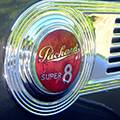
|
Thanks, Brian and BDeB, this helps tremendously. I'll open it up and take some photos. Those photos are really helpful. The drawings in the repair manual articles make a lot more sense now. (At the moment working on running boards.)
Thanks very much, Joe
Posted on: 2011/9/13 11:55
|
|||
|
||||
|
Re: 1940 Manual shift
|
||||
|---|---|---|---|---|
|
Home away from home

|
I opened the transmission per instructions, removing the cover plate in the floorboard. Disconnecting the forks from the linkage under the car. Taking out the bolts in the lid and wiggling the lid and forks out of the car.
The gears themselves look good to me, but I didn't rotate anything. The interlock block looks like it has a problem. Is this the wire for attaching a Quality Assurance tag? Don't think so. Looks like the source of the problem is the spring with the balls on the ends. From your photos, BDeB, it moved the forks so I could push the what was left of the spring and ball, and the solid cylinder and its mangled ball. Two of ball bearings look ok. Am going to take to nearby auto supply places and see if they can replace these. I'm pretty sure these are the source of my gear sticking problems, wouldn't you? I noticed that were 2 springs in here, and inner and an outer. Was this someone's creative solution to a faulty spring? Brian, one of those articles says the balls wear down the shifter fork and the forks have to be replaced. The fork doesn't look that bad to me (compared to those balls!). Obviously the balls and spring needs replacement, but I wonder how much contact there was with that spring jammed in there like that. It's a wonder I could shift at all. The last photo is of the fork that worked against the sprung spring. How does it look?
Posted on: 2011/9/17 15:02
|
|||
|
||||
|
Re: 1940 Manual shift
|
||||
|---|---|---|---|---|
|
Home away from home

|
I posted the results of my repair at The Duchess Project. Everything works and cleaning the solenoid contacts fixed the overdrive. Very happy camper.
I re-read this entire thread and I think I can make more improvements. 1. NEW 2-3 SHIFT ROD NEEDED. For some reason the horizontal 2nd-3rd gear shift rod is welded from 2 rods. (When I was a high school kid driving the Duchess, I'd take it to a shop for repairs. At one point, rather than rebuild the engine, I had it replaced with another 40 engine. When they put the new engine in, it didn't quite fit....because it was a 120 engine. Perhaps the 120 shift rod is longer than the 160s. Maybe the original rod was replaced with a longer one. Then when I replaced the 120 with a 160 engine in the 70s, shift rod was cut, modified and welded. I'll take a photo tonight. I would like to replace this rod with NOS or do as cortcomp suggests and make a new rod with female Heim joints. 2. I WOULD LIKE TO REPLACE THE 2-3 SHIFTER FORK proper, the one attached to the transmission cover. It's the ends that rub against the detent/interlock block and balls that wear. I wonder if there are any specs on what the gap distance should be between the detent ends of the forks and the interlock block itself. The articles specifically say the shift levers on the column rarely wear enough to warrant replacement (the new cast iron ones, that is), BUT the shifter fork ends that the detent balls snap into do wear. So, are NOS 2nd-3rd shifter forks available for '40 160? 3. THE DETENT/INTERLOCK SPRING. The ones (a lightweight wire spring with a diameter that fit the cylinder and a shorter smaller diameter spring inside it but of heavier gauge wire) that I found inside the cover that were bunged up are obviously not right. The parts book lists only one spring #330235. Looking at BDeB's photos above, I could see that the gauge is heavier, but zooming in I couldn't tell if it's 1 long spring or 2 short ones. The cylinder in the interlock block for the spacer is clear all the way through. The cylinder for the spring is not. There's a divider that juts about 1/4 of the diameter into the cylinder, that blocks the spring from fitting end to end. I tried to screw it in, but it wouldn't go, so I cut the string in 2 and put each half in an end. That's what's in there now and works, but if that's wrong, I want to replace it. I wonder if the correct spring is available. I will add a request in the Wanted forum.
Posted on: 2011/9/19 14:05
|
|||
|
||||
|
Re: 1940 Manual shift
|
||||
|---|---|---|---|---|
|
Home away from home
|
Joe,
The spring should be a single one. The one in the photo is actually broken in the middle and I just set it in position to give an idea of how the spring and balls are installed. Brian
Posted on: 2011/9/19 15:40
|
|||
|
||||
|
Re: 1940 Manual shift
|
||||
|---|---|---|---|---|
|
Home away from home

|
So I'm guessing you twist it in there somehow? And the divider inside the interlock block spring cylinder helps retain it?
Posted on: 2011/9/19 16:24
|
|||
|
||||
|
Re: 1940 Manual shift
|
||||
|---|---|---|---|---|
|
Home away from home
|
The spring just slides in to the smaller opening in the middle of the interlock block.
Posted on: 2011/9/19 18:51
|
|||
|
||||
|
Re: 1940 Manual shift
|
||||
|---|---|---|---|---|
|
Home away from home

|
I wish I could reconcile that a spring that small in diameter (to fit through the small hole) and the photo of the spring next to the spacer, and the size of the balls. The spring looks about twice the diameter of that smaller hole. If it sticks in gear, I'll open it up and replace the spring. But I wonder why the spring in the photo is broken. There isn't any force from the movement those balls that would do it. Maybe just old? Maybe wouldn't come out (like I couldn't get it in) so it was pulled out and cut? Just guessing now. I obviously don't get it. Thanks for being patient, Brian.
Posted on: 2011/9/19 19:25
|
|||
|
||||

 (56.70 KB)
(56.70 KB)